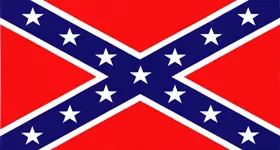Civil War Battles |
Colonial Wars |
American Wars |
Link To This Page — Contact Us —
The Battle of Lexington/Hemp Bales
September 13-20, 1861 in Lexington, Missouri
 |
|||||||||||||||||||||
|
Instilled with confidence from the Confederate victory at Wilson's Creek, near Springfield on September 10th, Maj. Gen. Sterling Price determined to rid the state of Kansas jayhawkers and Union sympathizers. By the 13th, former governor Price had led his 7,000 men of the Missouri State Guard to the outskirts of Lexington, a town of 1,000 men overlooking the Missouri River. two encounters with Union pickets that day marked the beginning of the siege.
Just north of the town, on the Masonic College campus, was a garrison of 2,800 troopers under the command of Col. James A. Mulligan, guarding several items they had confiscated from the town. Included in the cache were the great seal of the state and nearly $1 million from the bank in town, the latter buried under Mulligan's tent. The college was a strong defensive position, about 18 acres on a rise that looked down on the Missouri River to the west and on the town itself to the south. The college building became the spear-point of his stronghold.
With his own men, some Illinois cavalry and home guards he'd met in town, and the 13th and part of the 14th Missouri Infantry that had arrived that day. His men went to work immediately, throwing up massive earthworks from the entrance of the college westward toward the river. Between the lower works and the river's wharves and warehouses stood a fine brick mansion built by businessman Oliver Anderson; Mulligan turned it into a hospital. He also removed most of the trees and underbrush. His orders were to hold Lexington "at all hazards".
By September 12, Price's advance had reached the outskirts of town. For 2 days his men traded shots with Union pickets. At one point, the enemies blasted away at each other across a small graveyard, Machpelah Cemetery, in what locals called "The Fight over the Dead."
As heavy rains flooded the town, Price waited for the bulk of his army to arrive. Mulligan hoped for reinforcements that would never arrive. By September 18, Price was ready and ordered an assault.. His army advanced through town and surrounded Mulligan's position, cutting his men off from the river and a stream that had been their only source of water. After an exchange of artillery fire, a group of state guards charged up the bluff and captured the Anderson House, about 100 yards outside the Union entrenchments. From the building's upper floors, the soldiers began picking off scurrying Federals in the trenches. Mulligan, furious that a hospital was being used to house enemy snipers, ordered the structure retaken. Leaping from their muddy works, 80 of Mulligan's men raced downhill through a garden and retook the house. But the house was back in Confederate hands by sundown
On September 19, the Confederates consolidated their positions, kept the Federals under heavy artillery fire and prepared for the final attack.
By the morning of September 20, Price was ready to try something new. Scores of heavy bales of hemp sat in warehouses or on boats at the river's edge, awaiting shipment. By 8:00 A.M., Price's Missourians had maneuvered roughly 130 of these massive bales into two long lines flanking the Anderson House. After soaking the bales with water, the Confederates began pushing them forward, 3 men to a bale. The Federals poured rifle fire and heated shot into the oncoming bales, but to no effect.
By mid-afternoon, Price's strange, serpent-like lines constricted, leaving his outnumbered and desperately thirsty foes trapped. Inside the besieged Masonic College, Mulligan's men held a council of war and voted 4-to-2 to surrender.
Price was hailed throughout the South for his victory. His Confederates had recovered some $960,000 that Mulligan had taken from the State Bank of Lexington by order of Maj. Gen. John C. Fremont, commander of the Federal Department of the West.
The Battle of Lexington had no sweeping flank attacks, booming artillery duels, or massive armies. But it was real civil war - Missourian against Missourian.The battle was one of several battles fought to determine the allegiance of Missouri, crucial to both North and South for its resources and proximity to the Missouri and Mississippi Rivers.
Despite the sensational victory, Price was unable to equip his entire force of volunteers, and enthusiasm dropped so much that his command dwindled to its original compliment of 7,000. Fremont's strong, newly formed army of 38,000 eventually forced him from the state.
